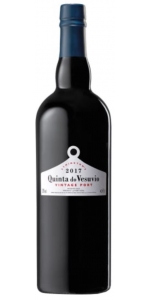Wine from Quinta do Vesuvio

Symington Family Estates is one of the world's leading producers of premium port, the leading vineyard owner in the Douro Valley and one of the top Portuguese wine producers.
We are a family of British and Portuguese origin that has lived and worked in Portugal since the 19th century. Our family business - run by the 4th and 5th generation - is founded on a deep commitment to Portugal's people, its lands and its wines. Today there are 10 family members working across the business, committed to producing the finest ports and wines and building on the achievements of the previous generations.
We own and run four of the leading port houses, Graham's, Dow's, Warre's, and Cockburn's, as well as a portfolio of Douro wines consisting of Quinta do Vesuvio, Quinta do Ataíde, Altano, and Prats & Symington (a widely acclaimed joint venture that produces Chryseia and Post Scriptum). We have recently launched a new project, Quinta da Fonte Souto, in the Alto Alentejo sub-region of Portalegre.
We are the leading vineyard owners in the Douro Valley with 26 Quintas covering a total of 2,255 ha of which 1,024 ha are under vine. The remainder is mostly natural mediterranean scrub with some olive and citrus groves. Our largest vineyard is Quinta do Vesuvio in the Douro Superior with 133 ha, and our smallest is the 7 ha Quinta da Madalena in the Rio Torto valley. All our vineyards are managed under a strict minimum intervention policy and 112 ha are organic, which make them the largest area of certified organic vineyard in northern Portugal.
The Douro is the world’s largest area of mountain vineyard and a Unesco World Heritage site. Our vines are planted on steeply terraced hillsides and much vineyard work continues to be done by hand - an increasing rarity in the world’s great wine regions. Our indigenous vines provide low yields of very high quality grapes, due to their natural adaptation to our climate and our well-draining schistous soils.
Many of the region's historic vineyards are owned by our family, including Vesuvio, Malvedos, Bomfim, Cavadinha, Senhora da Ribeira, Tua, Canais, Retiro, Ataíde and Roriz (the latter with the Prats of Bordeaux). We are unique amongst the historic port companies in that all our working family members farm their own vineyards, along with those under the family’s joint company ownership.
Our ports and wines consistently win major international wine awards. We produced the only port made this century to score 100 points in the Wine Spectator: Dow’s 2007 Vintage Port. Dow’s 2011 Vintage Port scored an exceptional 99 points in the Wine Spectator in 2014 and was placed at No.1 in the prestigious Top 100 Wines. Chryseia 2011 was placed at No.3 in the same year, the highest ever ranking for a Portuguese red wine, and Chryseia has now appeared in the list three times.
We are leading innovators in viticulture and winemaking with a dedicated R&D team. We run experimental vineyards at Quinta da Cavadinha in the Pinhão valley, at Quinta do Ataíde in the Vilariça valley and at Quinta do Bomfim. Our grape variety libraries at Ataíde (53 grape varieties) and at Bomfim (31 grape varieties) are the largest collection of indigenous varieties in Portugal. Through these projects we are aiming to preserve our country's viticultural heritage whilst conducting important analysis on the ability of our vines to adapt to climate change.
We developed the first modern treading lagar in 1998, which represented a significant advance in the making of premium quality ports. These now operate in four of our specialist estate wineries producing outstanding ports in the classic way.
We run three award-winning visitor centres with highly professional, passionate and knowledgeable teams of guides: the Graham's 1890 Lodge, the Cockburn's Port Cellars (both in Vila Nova de Gaia across the river from Porto), and Quinta do Bomfim in Pinhão in the Douro. The Graham's Lodge is home to Vinum, a restaurant that combines fine wine with Portuguese gastronomy.
We own and run three distribution companies dedicated to the sales and marketing of family-owned fine wines and ports: Portfolio in Portugal, Fells in the UK, and Premium Port Wines in the USA. We are proud to work with an excellent network of distributors who sell our ports and wines in over 100 countries around the world.
In 2017 we acquired a beautiful estate called Quinta da Fonte Souto in the Serra de São Mamede, part of the Portalegre sub-region in the Alto Alentejo region of southern Portugal. We believe that this relatively high altitude region has fantastic potential for producing fine wines.
We support several projects that contribute to the wellbeing of our region. Every year for the last eleven years we have donated an ambulance to different Volunteer Fire Brigades in the Douro region which are used to serve the local community. We support Bagos d’Ouro, an organisation that helps underprivileged children in the Douro. Each year we provide scholarships to two new students for the viticulture and oenology degree at UTAD (Vila Real), Portugal’s leading university in this field. We have been a long-term sponsor of the UTAD birds of prey programme that releases rehabilitated birds into the Douro region.
We are long-term sponsors of the Institute of Master of Wine and the Wine & Spirit Education Trust (WSET).
Quinta do Vesuvio Single Quinta Vintage Port is made from 33% Touriga Nacional, 35% Touriga Franca, 15% Sousão, 12% Alicante Bouschet, 5% Other.
This is a powerful, attention-grabbing wine, with taut muscularity. It offers magnificent aromas of rockrose, mint and hints of ginger. The substantial palate is full with expressive black fruit notes lifted by peppery schist tannins (the seasoning provided by the Sousão). The long, lingering aftertaste indicates impressive ageing potential.
Review:
Deep dark ruby garnet, opaque core, violet reflections, delicate edge brightening. Delicate smoky spice, fine nougat, black berries, ripe figs, candied orange zest. Juicy, elegant, fine extract sweetness, ripe tannins, pleasant freshness, chocolaty in the finish, mineral and long-lasting, extremely elegant style, a large Vesuvio, has class.
-Falstaff 99 Points
The 2017 Vintage Port is a blend of 33% Touriga Nacional, 35% Touriga Franca, 15% Sousão and 12% Alicante Bouschet, plus miscellaneous others filling out the blend. This was bottled about a month before tasting after 18 months in seasoned vats, but the just-bottled sample was not really ready. This was instead a pre-bottling sample. It comes in with 115 grams of residual sugar.
- Wine Advocate 99 Points
- back
Selected Options
Wineries
Categories
Pricing
Countries
Regions
Grape Types
Wineries
Organic/Free Shipping
Saumaize-Michelin Pouilly-Fuisse “Clos sur la Roche” is made from 100 percent Chardonnay.
Produced from the oldest parcel of the estate dating back from 1979 and planted on the slopes of the Vergisson Rock, "Clos sur la Roche" benefits from a south sun exposure. This beautiful Chardonnay offers abundant floral and white fruit aromas, toasty and buttery notes and brioche scents. Well-balanced and concentrated on the palate with a rich structure and refreshing notes of zesty lemon and mineral purity that brings a vibrant energy to the finish.
Complex aromas of soft citrus fruits and minerals. Densely packed and fresh, with intense, complex flavors of white fruit as well as a hint of spice. The finish is very firm, long but not dry.
This site is now a Premier Cru!
Long Shadows Poets Leap Riesling is made from 100 percent Riesling.
Tasting Notes: The Poet's Leap Riesling offers aromas of white peach, jasmine, Thai basil and nutmeg. Flavors of ripe melon, apricot and an appealing minerality continue across the palate. An underlying hint of honey sweetness is balanced by a streak of bright acidity that provides a long, clean finish.





